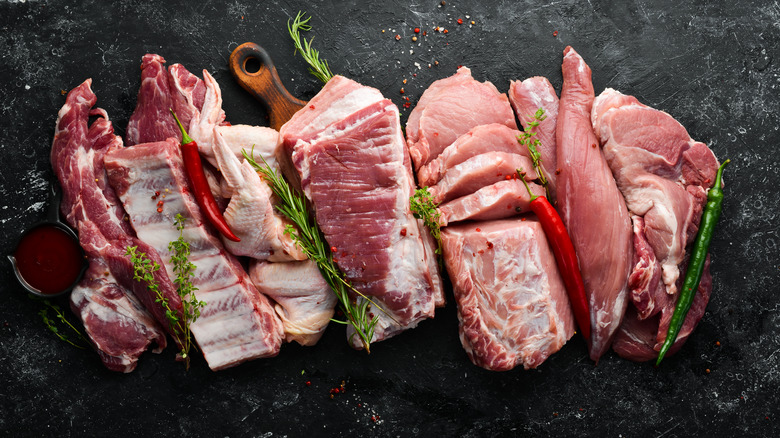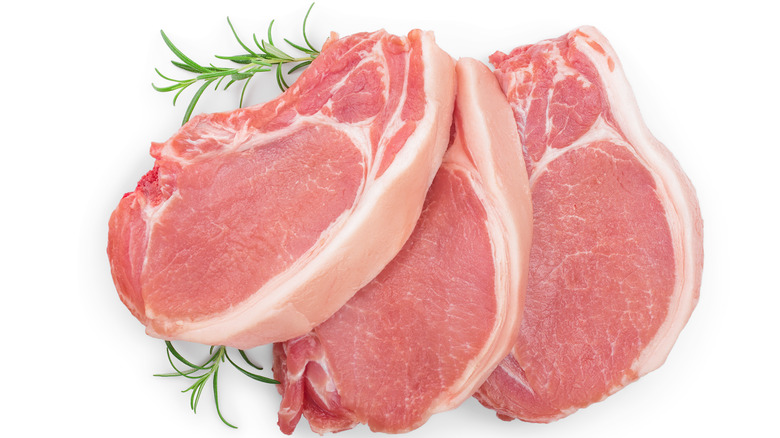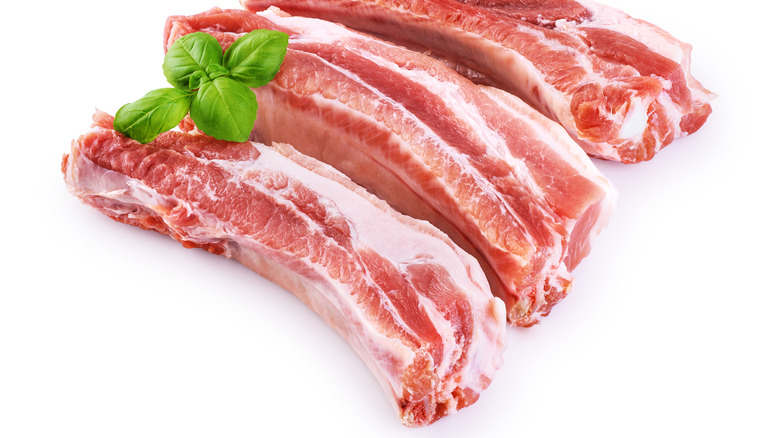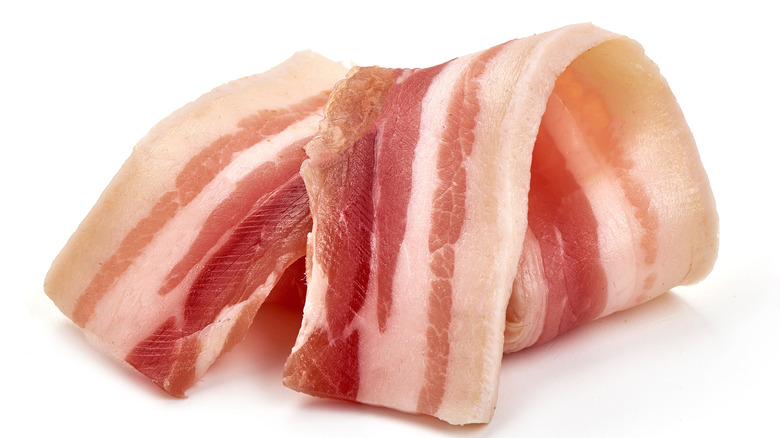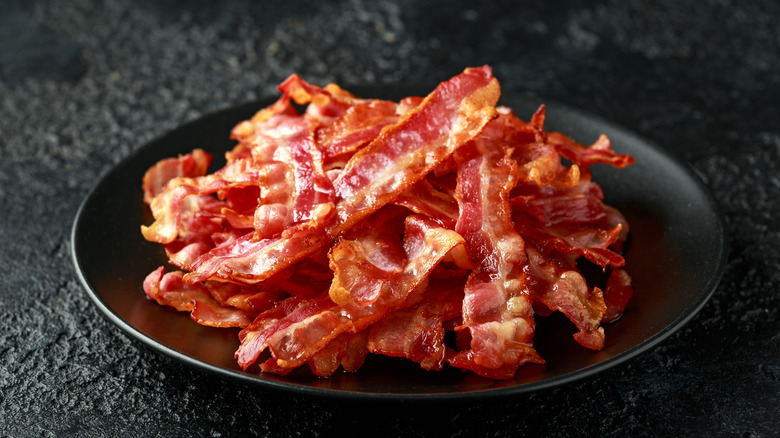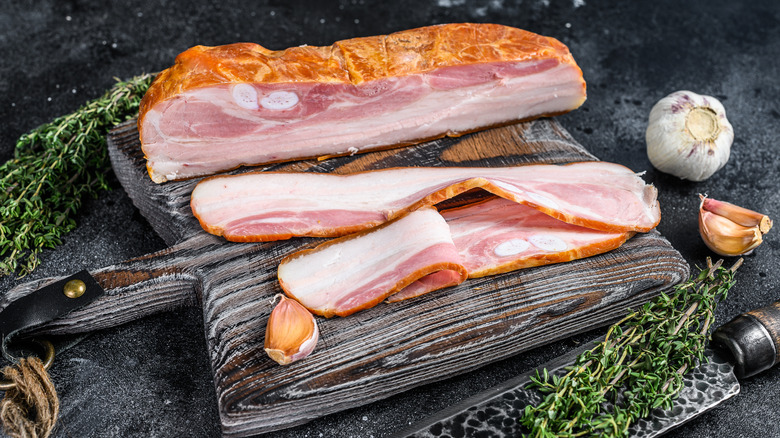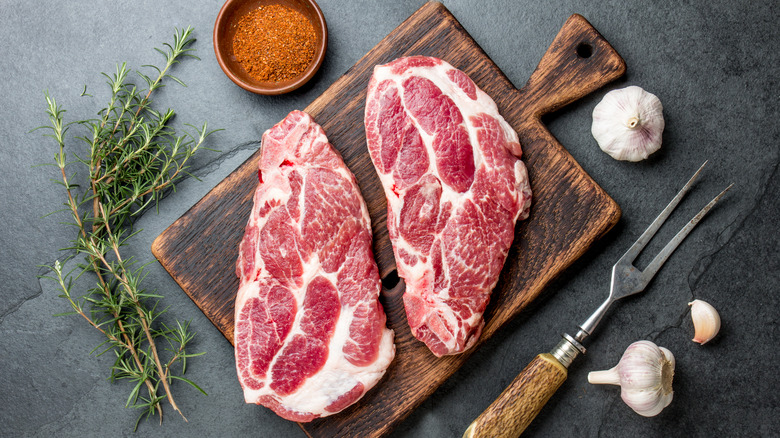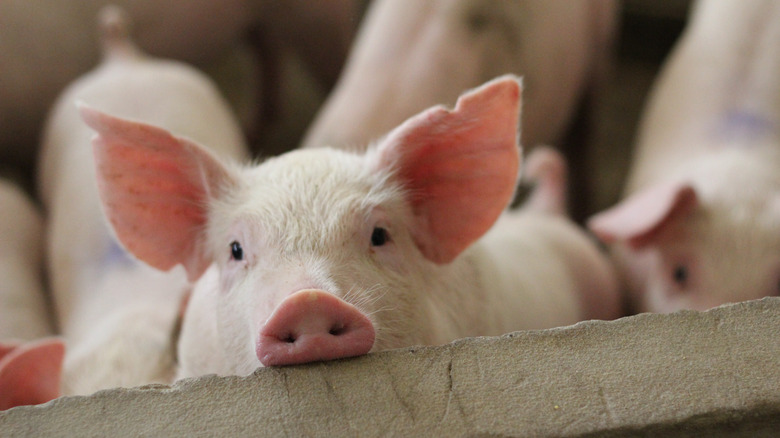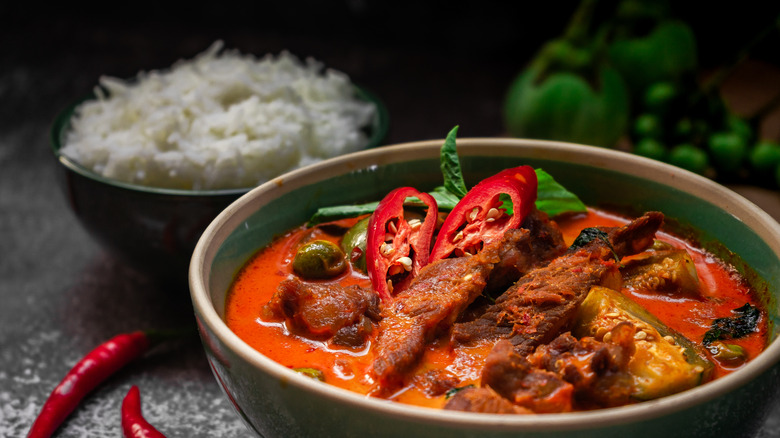False Facts About Pork Everyone Actually Believes
If you grew up in the 80s or 90s, you undoubtedly think of pork as "the other white meat." And truth be told, pork does seem to marry the best of all meat worlds: From the mild-flavored, lean loin for which the slogan was crafted back in 1987, according to the Pork Checkoff, to the richly flavored bacon that has found its way into everything from mac and cheese to chocolate truffles (and, for that matter, bedecks many a t-shirt), pork is a varied and beloved meat.
But there's also probably quite a bit that you don't know about this dinner table staple. Pork can also be divisive. It's eschewed by certain religious groups including Jewish and Muslim communities, according to Chabad, and links to cancer have meant that some health-minded individuals and groups steer clear of pork, too (via Healthline).
It's time to set the record straight. Here are a few false facts about pork that everyone believes.
Pork is a white meat
Let's begin at the beginning: with that catchy slogan launched by the National Pork Producers Council in the late 80s – a $7 million investment, according to The Best Stop. Pork Checkoff writes that the goal of the campaign was to highlight the healthfulness of pork, aligning it in the minds of consumers with lean poultry instead of with fattier beef. And it worked! Not only, The Best Stop reports, did pork consumption rise by nearly 20% in the years that followed the campaign's launch, but according to one 2000 study conducted by Northwestern University, "The Other White Meat" was the fifth most memorable tagline in modern advertising.
But there's one major issue with this slogan: It's not true. Red meat is defined, according to The Best Stop, as any meat coming from a mammal, and since pigs are definitely mammals, their meat is red, despite it being paler in color than either beef or lamb.
Pork is unhealthy
The goal of comparing pork to poultry was, it seems, to highlight its healthfulness as compared to other red meats. In this case, we've got to hand it to the National Pork Producers Council: Despite widespread myths that pork is unhealthy, according to WebMD, pork is actually a good source not only of protein but also of B vitamins and minerals like niacin, iron, and zinc. Pork is richer than other red meats specifically in the B vitamin thiamine, and a six-ounce pork chop also boasts all of your daily recommended dose of selenium.
According to Livestrong, pork chops boast more nutrients than sirloin, and The Washington Post contends that pork — particularly lean cuts — can be a good part of a healthful, balanced diet. (These cuts, the outlet contends, can usually be easily identified due to the word "loin" in their name — like loin chop or tenderloin.)
And pork is actually getting leaner! According to one 2006 study from the USDA, six common cuts of pork are an average of between 16% and 27% lower in saturated fat than they were 15 years ago. Pork tenderloin, the study contends, is now as lean as skinless chicken breast. So comparisons to white meat aren't wholly unfounded, after all.
Pork fat is particularly unhealthy
While experts certainly tout the heath benefits of lean pork, fattier cuts are a bit murkier. Indeed, The Washington Post indicates that while lean pork is a great addition to a balanced diet, fatty portions should be used in moderation as a flavoring agent rather than as a main meal.
But pork fat doesn't actually deserve its bad rep. According to the BBC, pork fat is a nutritional powerhouse, slightly less nutritious than Swiss chard but slightly more nutritious than beet greens. The outlet notes that pork fat is more unsaturated and healthier than the fat of either beef or lamb, ultimately ranking not just pork but pork fat specifically in 8th place overall on a list it published of the 100 most nutritious foods in the world. Indeed, according to one Singapore-based nutritionist interviewed by AsiaOne, "as long as it's pure and unprocessed," pork fat "can be beneficial for the body." Seems like grandma was right to cook everything in lard!
Bacon causes cancer, so you shouldn't ever eat it
With myths of pork's unhealthiness thusly debunked, it seems that we can dig in to our hearts' content — with one exception: bacon. A few years back, headlines proliferated pointing to this breakfast favorite as being particularly rich in carcinogenic compounds, an issue linked to its categorization as a cured or processed meat (per the World Health Organization).
Multiple studies, Healthline reports, have linked high consumption of processed meats to certain types of cancer, due in large part to the use of the preservative sodium nitrate. According to The Conversation, this is due to three linked substances: N-nitroso compounds that form in the stomach when nitrites are digested, heterocyclic amines (HCAs) that form when bacon is fried, and advanced glycation end products, which, like HCAs, are produced when bacon comes into contact with heat — and, in particular, the high heat of the grill or broiler.
But while one study showed that eating just two slices of bacon a day contributed to an 18% higher risk of colorectal cancer, according to Forbes, the carcinogenic risks of bacon have actually been portrayed in drastically outsized light. The outlet delves deep into the picture these numbers seem to paint, noting that the relative risk increase is actually minimal. So while it's not a great idea to gorge yourself on it (if only for the sodium content!), enjoying bacon in moderation is actually a-okay.
"Nitrite-free" bacon is healthy
When word got out that bacon was ostensibly causing cancer due to its use of nitrites as a preservative, a swath of brands proliferated selling more natural, ostensibly nitrite-free bacon. But, The Conversation asserts, not all is as it seems with this label.
Bacon products advertised as "nitrite-free," the outlet asserts, manage to remove the substances by way of a loophole, replacing synthetic nitrites with vegetable-based ones (gleaned, for example, from celery, according to Firsthand Foods). These "natural" nitrites, the Conversation continues, may come from a recognizable vegetable source, but their effects on the body are the same: They still convert into carcinogenic n-nitroso compounds when fried, especially at very high heat.
Since bacon isn't nearly as carcinogenic as mass media would have you believe, this fact may seem moot. The moral of the story, in this case, is that eating the bacon you love (in moderation) probably won't kill you, whether the nitrates come from a lab or a vegetable.
You should never eat pork rare
When you go to a restaurant and order other red meats like beef, lamb, or duck, the waiter will often ask you how you'd like it cooked — Rare? Medium? Well-done? But when it comes to pork or poultry like chicken, the question is never posed. The reason, it seems, is simple: It's dangerous to consume undercooked pork, which, according to WebMD, can result in either parasitic infections linked to the presence of Taenia solium (a tapeworm) or trichinosis linked to the presence of parasitic roundworms called Trichinella.
But some experts assert that rare or even raw pork is a delicacy on par with other raw animal proteins like sushi or steak tartare. Serious Eats cites California chef Chris Cosentino's pork crudo or the pork carpaccio at Toronto's The Black Hoof as prime examples of how, in the right hands — and with the right safety precautions — raw pork can actually be a very tasty treat.
At home, at the very least, you can rest assured that you don't need to cook your pork until it's dry as a hockey puck to enjoy it safely. According to Marianne Gravely of the USDA's Meat and Poultry Hotline, speaking to Serious Eats, trichina isn't nearly as much of a worry as it once was. Taste of Home goes so far as to contend that pork cooked to an internal temperature of 145 ºF — about medium rare, and with a slightly rosy hue — is safe and delicious to eat.
Pigs are dirty animals
Perhaps one of the most pervasive stereotypes around pigs is about their dirtiness. After all, parents criticizing their kids' rooms call them "pigsties," and when you stuff yourself, you're liable to be called a "pig." But this myth is grossly exaggerated, bordering on blatantly untrue. Pigs, according to National Geographic, are actually quite clean; their unfortunate reputation stems from their habit of rolling in the mud, not to make a mess, but rather to cool off. It's not pigs' fault — but rather ours — that in some cases, hog-raising facilities are just as dirty (if not more so) than stereotypes would have us believe. North Carolina's hog industry notably pumps millions of tons of hog waste into rank-smelling lagoons as part of its factory farming practices; these farms, The Guardian notes, have been identified by studies and environmental groups as a phenomenal ecological and health hazard that is in no way the fault of the pigs themselves.
If we're pointing fingers at hogs for their piggish diets, meanwhile, that's another place where we're the ones to blame. In some cases, The Denver Post contends, high corn prices have led farmers to feed hogs candy and sugary breakfast cereal. While pigs are indeed omnivores, according to Hobby Farms, their digestive systems are actually quite similar to ours, so anything unhealthy to humans shouldn't really be fed to pigs.
Pork isn't eaten in India
India boasts a long and complex relationship with vegetarianism, asserts The Conversation, but the specificity of its relationship with pork bears some clarification.
It is indeed true that some communities around the world opt not to eat pork for religious reasons. Jewish communities, according to My Jewish Learning, eschew eating the flesh of any animal without cloven hooves that does not chew its own cud (which, by the way, also includes camels and rock badgers); Muslim communities, too, avoid eating pork, which the Quran prohibits as "impure" due to the pig's nature as a scavenger, according to Islam Faith. India is home to a number of different religious groups, including Christians, Muslims, Sikhs, Buddhists, and Jains, according to the Pew Research Center. Some of these religions preclude eating meat entirely, such as Buddhism and Jainism, and India's Muslim communities do indeed eschew pork, and some of its Hindu population eschews beef, according to The Atlantic. That said, the BBC paints Hindus, who make up 80% of the country's population, as "major meat-eaters," and within this religion there's no particular preclusion from the consumption of pork.
Indeed, according to This Week in Asia, while pork is not that common in Indian cuisine, traditional pork dishes can be found in the states of Goa, Kerala, and Karnataka, and pork has been integral to the cuisines of some communities since as far back as the 12th century.
Hot dogs are made of pork
Sausages are made around the world, and according to Il Porcellino Salumi, while sausage can be made of nearly any meat you can think of, most of it is indeed made from pork — at least in part. From the lap cheong of China to Germany's bratwurst, from to France's blood-based boudin to spiced Cajun andouille, sausages come in all shapes, sizes, and flavor profiles. And while other meats can often join the party, like veal in the case of weisswurst, there's usually at least some pork in there.
One prominent exception? Perhaps the best-known American sausage: the hot dog.
There's probably a lot about hot dogs that you didn't know. Chief among them, for our purposes: the fact that most of them, according to Coleman Naturals, are made from beef trimmings, and the cheaper ones are often, Refinery29 asserts, made not with beef or pork but rather with mechanically separated chicken.
Pork is cheap
Stand in any grocery store meat aisle and it may seem as though pork is the cheapest meat around. Cheaper, certainly, than steak or lamb, according to Butcher Magazine, pork is often an affordable option. This stems in part from the innate ease of breeding and rearing pigs, plus the lack of expense of feeding the hogs, Foodosity explains. For these reasons, pork can be cost-effective to raise and therefore can be a less expensive option for those looking to put meat on the table. Emphasis on can.
Contrary to common perceptions to the contrary, CNN in 2021 painted pork as "super expensive," not just because of supply chain issues linked to the pandemic, but also because animal welfare laws are cracking down on the inhumane practices that led to pork's particularly low price point. These issues are nothing new, and were highlighted years before by One Green Planet, which, in exploring the "hidden costs of cheap pork" highlighted animal welfare and also the environmental hazards of the demand for such inexpensive pork. So if you see pork prices skyrocketing, take heart: It's probably because quality is going up, too.
